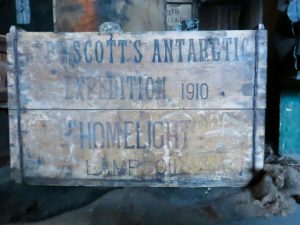 My friend Paul Taylor and I are junior authors on a paper that has just appeared in the journal Geochemistry, Geophysics, Geosystems (“G-Cubed”) as an in press accepted manuscript. We’ll be the first to admit that it is a bit outside our comfort zone in geology, but our contributions, along with those of the other authors, are a good example of interdisciplinary team work. We were led by Dr. Andrea Erhardt at the University of Kentucky. This project took about four years from first draft to published article. Here is the abstract —
My friend Paul Taylor and I are junior authors on a paper that has just appeared in the journal Geochemistry, Geophysics, Geosystems (“G-Cubed”) as an in press accepted manuscript. We’ll be the first to admit that it is a bit outside our comfort zone in geology, but our contributions, along with those of the other authors, are a good example of interdisciplinary team work. We were led by Dr. Andrea Erhardt at the University of Kentucky. This project took about four years from first draft to published article. Here is the abstract —
This study uses the chemical composition of early carbonate cement precipitates in carbonate hardgrounds to understand the geochemical signature of near-surface carbonate mineral precipitation. As carbonate hardgrounds lithify at or near the sediment-water interface, they acquire cements that may be minimally evolved from paleo-seawater. While hardgrounds can be subaerially exposed during sea-level regression, geochemical changes from interactions with meteoric water can leave a distinct geochemical signature. Using a suite of chemical measurements, we explore the potential of carbonate hardground cements as paleoenvironmental proxies. Trace metal and isotopic ratios, including rare earth elements, Mg/Ca, manganese and strontium concentrations, d18O, d13C, and 87Sr/86Sr, were analyzed in the carbonate cements from 17 Phanerozoic carbonate hardgrounds. Of these samples, only our sample from the modern oceans has measurements consistent with primary precipitation from seawater; all other samples precipitated from chemically evolved seawater or were influenced by meteoric water, even if only minimally changed. While the more recent Cenozoic samples had seawater 87Sr/86Sr, the Mesozoic samples, in contrast, did not preserve seawater 87Sr/86Sr, even though the Mg/Ca, d18O, and d13C values were consistent with precipitation from seawater. Finally, the Paleozoic samples preserved expected seawater 87Sr/86Sr, though REE and d18O suggest primary precipitation was from evolved seawater. Additionally, we place our results in the context of open vs. closed system precipitation using transects of the Mg/Ca ratios across individual cements. Overall, we stress that one proxy provides only a partial record of fluid composition, but multiple measurements allow a potential understanding of the seawater geochemical signal. [Sorry that I couldn’t figure out how to include superscripts and Greek letters!]
Fortunately this journal requires a Plain Language Summary —
All potential archives for reconstructing ancient seawater chemistry have complicating factors, be it biological modification or secondary alteration. This study investigates a promising alternative, carbonate hardground cements. As carbonate hardgrounds form relatively quickly and in equilibrium with seawater, if a sample has remained unaltered it should retain the primary seawater chemistry. We evaluate 17 samples from across the Phanerozoic, compiling trace element concentrations and isotopic ratios to determine if a sample has undergone significant diagenesis. Overall, no ancient sample satisfies all criteria, but the suite of measurements allows for an evaluation framework for future samples.
Hardgrounds are synsedimentarily-cemented seafloor. In other words, sediments that have essentially lithified into rock on the seafloor. The top image is of an echinoderm-encrusted Ordovician carbonate hardground from the Kanosh Formation of west-central Utah, which was included in this study. I’ve loved hardgrounds for decades now, learning much from my friend, the master of hardgrounds, Tim Palmer of the University of Wales, Aberystwyth. You can see in the first sentence of the discussion in this paper the primary role Paul Taylor and I played: “Our samples were selected based on evidence of early lithification at the sediment/water interface through the presence of marine boring and encrusting organisms.” That early lithification is with calcite cement generated from seawater in some form, thus the possibility that these hardgrounds are archiving ancient seawater composition. Seawater composition, of course, tells us much about marine paleoenvironments.
 Figure 4 caption: “Mg/Ca ratios, strontium concentrations, and Mn/Sr ratios for samples showing examples of A) closed and B) open system precipitation behavior. Samples from potential closed system environments show an increase in Mg/Ca ratios along the growth axis, while samples from open systems show uniform Mg/Ca ratios. Strontium concentrations and Mn/Sr ratios can be indicators of diagenetic alteration, with thresholds of less than 300ppm for strontium and Mn/Sr ratios greater than 2 consistent with carbonate recrystallization under chemically evolved pore waters. The red lines indicate the trace of the LA-ICPMS.”
Figure 4 caption: “Mg/Ca ratios, strontium concentrations, and Mn/Sr ratios for samples showing examples of A) closed and B) open system precipitation behavior. Samples from potential closed system environments show an increase in Mg/Ca ratios along the growth axis, while samples from open systems show uniform Mg/Ca ratios. Strontium concentrations and Mn/Sr ratios can be indicators of diagenetic alteration, with thresholds of less than 300ppm for strontium and Mn/Sr ratios greater than 2 consistent with carbonate recrystallization under chemically evolved pore waters. The red lines indicate the trace of the LA-ICPMS.”
One aspect of this project I appreciate very much: The results are fuzzier than we expected. No single geochemical proxy shows a full record of the composition of the original cementing fluids. It is the combination of proxies that gives us the best clues, which is an incremental move towards better understanding of ancient seawater geochemistry. It is nice to see such data, observations and ideas published without a tight evidentiary ribbon around it all. Science in progress!
Reference:
Erhardt, A.M., Alexandra V. Turchyn, A.V., Dickson, J.A.D., Sadekov, A.Y., Taylor, P.D., Wilson, M.A. and Schrag, D.P. 2020. Chemical composition of carbonate hardground cements as reconstructive tools for Phanerozoic pore fluids. Geochemistry, Geophysics, Geosystems (in press; accepted manuscript online; https://doi.org/10.1029/2019GC008448).



































































